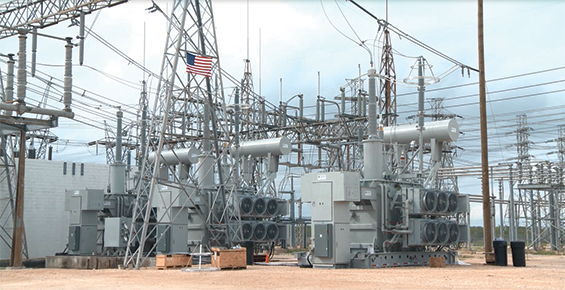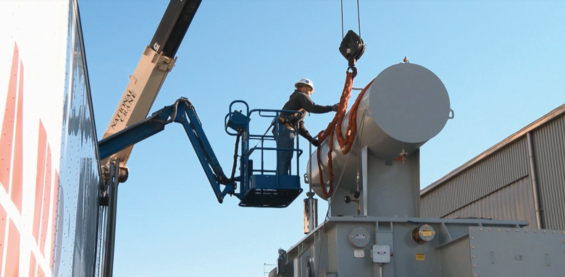Rapid Recovery Transformer advancements – as well as new assessment, monitoring, hardening and rapid repair capabilities – can help utilities boost grid reliability and minimize exposure to potential attacks and outages
The grids that make up North America’s power infrastructure have had a long, proud history of relative stability over the past century. And the U.S. electric utility industry has earned a long, well deserved track record of reliability. Extended outages have been rare.
The financial and emotional impact of a long-term outage on a nation cannot be underestimated. For example, the damage that led to astronomical costs associated with regional severe-weather related outages such as Superstorm Sandy, the major hurricane and severe weather system that hit the Northeast in 2012, directly impacted the economy as well as the U.S. presidential race. In 2012, a Congressional Research Service study estimated the inflation-adjusted cost of weather-related outages at $25 to $70 billion, annually. Fortunately, proper planning and quick reaction following Sandy kept major outages under control, and power was restored to more than 95 percent of customers within two weeks.
Storms and Snipers
And now in this post-9/11 era, on top of these major weather-related disaster concerns, comes a wave of physical attacks on targeted substations and power transformers around the country. Between 2011 and 2014, according to USA Today, electric utilities reported 348 physical attacks that caused outages or other power disturbances.
The most high-profile incident occurred in 2013 in California, where snipers took direct aim at a unidentified substation serving Silicon Valley by cutting hard-wired communications and firing high powered rifle shots at 17 transformers and six circuit breakers, causing 52,000 gallons of oil to be spilled and $15.4 million in estimated restoration costs. Fortunately, there were no significant outages, as there was a massive – and successful – effort to reroute power and restore service.
These physical attacks led the North American Electric Corporation (NERC) to quickly file a petition for the approval of reliability standard NERC CIP-014 requiring transmission owners to assess the vulnerability of critical substations and development & implement security plans. The implementation schedule for this order started in October, 2015 and requires completion by August 2016. NERC created this project to address the directives issued in the FERC Order on Reliability Standards for Physical Security Measures under Docket No. RD14-6-000 issued March 7, 2014.
The importance of power transformers
Large power high voltage (HV) transformer units today make up less than three percent of the total number of transformers on the grid; however, they carry 60-70 percent of the nation’s electricity, so it is vital to protect these assets.

Power transformers are widely recognized to be the most critical asset in the substation. Many utilities have some version of spare transformers on hand, however there is a very limited availability of spares. Spares are often in the same location as a potential attack, and there is rarely more than one available per substation. Every transformer in America is designed for a particular application, and few transformers are alike, especially at high voltages. Manufacturing lead times are long, and involve complex processes around design, procurement, production, testing and deployment. There are difficulties with transportation, as large, heavy units are rarely able to be transported on trucks. Most transformers are shipped via rail transportation, which often takes weeks of planning and implementation. And finally, there is much specialty equipment and skills required in the installation of these transformers. Dimensions are critical. Many times, new concrete pads must be created, and many hours of civil work are required.
Absolute physical security of America’s grid infrastructure or its substations is not practically achievable if not downright impossible. Vulnerabilities hinge on attackers’ intentions, skill and resources. There is no way to absolutely protect a substation transformer and other electrical equipment from severe damage from an intentional attack. It is possible to make the damage less severe, prolong service and restore service more quickly with a layered approach to physical security. When damages exceed repair capabilities, rapid replacement strategies play an important role in transformer recovery. Critical transformers need spares, universal spares, and an on-the-shelf design for critical assets.
Successful ‘RecX’ Concept Demonstration
In 2012, a new consortium led by the U.S. Department of Homeland Security (DHS), which included ABB, the Electric Power Research Institute (EPRI), and CenterPoint Energy, launched a new Rapid Recovery Transformer (RecX) program. The concept actually began prior to 9/11 with EPRI’s Infrastructure Security Initiative (ISI), where the feasibility of a fast-to-install transformer design was first examined. ABB was tasked with designing a conventional oil-filled spare transformer with ease-of-transport and fast-to-install concepts. DHS became involved after the project created a less-than-one week storage to transformer energization concept. And CenterPoint, the utility host, supported a trial deployment and designated one of its substations to house the first RecX.
The RecX consortium held a timed concept demonstration, a ‘fire drill’ for deployment of the spare transformer, in 2012. The consortium would transport this prototype transformer that could replace a failed extra-high-voltage (EHV) transformer in about a week as opposed to several months. A trio of single-phase 200-MVA, 345/138-kV autotransformers would be disassembled, loaded onto a specially designed over-the-road trailer, transported more than 900 miles (1,448 km), reassembled and energized in less than one week in the designated substation. RecX comes with its own optional pad and does not require the use of a crane to unload, a big time saver as opposed to pouring and curing a concrete base. One of the units in the demo came with this pad.
The drill began on a Monday morning, March 12, 2012 at the ABB transformer manufacturing plant in St. Louis, Missouri. The partially assembled unites were pulled from storage, simulating an actual emergency scenario, and placed onto two conventional lowboy trailers and a 65-ton capacity trailer (MA65) specially designed for a trip to Houston. The MA65 was modeled after an over-the-road Schnabel railcar, and proved to be amazingly versatile.
The trailers all arrived by Tuesday evening, and assembly began on Wednesday morning. And on Friday evening, after experienced CenterPoint assembly crews worked 12-14 hour days and much of the testing and installation was done, it was near completion. The project was indeed completed on Saturday morning, March 17. The RecX transformer and associated units were successfully energized by Saturday evening – Five days, 10 hours, and 10 minutes after the simulation first started. A one-year monitoring period for evaluating performance was then successfully started and completed. And today, as of late 2015, the RecX prototype spare transformer is still humming along and working as originally designed.

Utilities have noted the RecX’s large power capabilities, allowing for high voltage ratings; its compact and flexible design, including three individual single-phase units, hybrid NOMEX® insulation system for reducing size while maximizing power, and its remote cooling system. Just as important, these spare transformers enable rapid deployment, with transportation and installation now happening in days versus weeks.
A recent study concluded that the single most utilized transformer in the U.S. holds a voltage ratio of 345-138 kV. This demonstration exercise successfully created, deployed and energized three single-phase 200 MVA, 345-138 kV units that are small enough to be transported over U.S. Interstate highways, dramatically reducing transport times as compared with conventional rail transportation.
Five Steps to Better Substation Resiliency
Since the first Rapid Recovery Transformer (RecX) was first installed in 2012, technology advancements have continued and the power industry has come together to begin working out the complex weave of economic, security and practical concerns. The U.S. Department of Energy (DOE) has picked up where DHS left off, issuing a well-received report, ‘Large Power Transformers and the U.S. Electric Grid,’ around how the loss of large power transformers (LPT’s) could result in grid exposure. NERC CIP-014-1 has been initiated, requiring utilities to be compliant by August 2016.
And ABB, in consultation with several electrical utilities and the DOE, has recently launched a ‘Substation Physical Security and Resiliency Initiative’ to help utilities reduce the impact of and quickly restore the grid after a natural or man-made disaster. This initiative covers five strategic elements that will help these utilities restore power as quickly as possible. These steps include:
- Assessment – Assess the asset risk to extreme weather events, intentional criminal attacks, geomagnetic disturbances (GMD) and electromagnetic pulses (EMP)
- Hardening – Harden substations and power equipment against malevolent attack and extreme environments
- Monitoring – Remote monitor the asset and surroundings and automate response to abnormalities
- Rapid Repair – Rapidly repair lightly damaged power equipment, allowing utilities to quickly restore their equipment following an incident
- Rapid Replacement – Rapidly replace severely damaged power equipment
New ballistic protection system is unveiled for transformers under fire
ABB, as part of a new substation and grid resiliency initiative, has just introduced AssetShield™ a first-of-its-kind solution to shield and protect large power transformers and other substation equipment from ballistic attack. AssetShield currently meets UL-752 Ballistic Standards – Level 10 Rating.
AssetShield is an impact and fragmentationprotective system for substation equipment such as transformers, switchgear, circuit breakers, and capacitors. It reduces the kinetic energy of the bullets and reduces spalling after impact.
The U.S. is more dependent than ever on reliable electric power for residential, commercial and industrial use as well as strategic security. However, a physical or terrorist attack on the grid could result in widespread power outages and significant economic losses for utilities and the nation. The loss of certain large power transformers (LPTs) could result in exposure to the grid.
The North American Electric Reliability Corporation (NERC) has recently issued the first draft of a standard for physical security measures (CIP-014-1), mandating that all electric utilities identify and protect critical substations within their system. AssetShield has been tested to protect transformers and their sensitive components by withstanding various types of gunshots at varying distances.
“Absolute physical security for a substation is not practically achievable, but with AssetShield and other protective actions, it’s possible to minimize the damage, prolong service and restore service more quickly when there is an attack,” said Emily Heitman, ABB Vice President and General Manager of Commercial Operations for Power Transformers in North America. “ABB is pleased to introduce AssetShield to support electrical utilities and address security concerns around large power transformer and substation vulnerability.”
Currently, DOE is preparing to submit a plan to the U.S. Congress evaluating the feasibility of creating a strategic transformer reserve for strategic storage of spare LPT’s in sufficient numbers to temporarily replace severely damaged power transformers. This plan would include a description of the appropriate number of spare transformers needed as well as total capacity in megawatts as well as strategic locations for transformer storage, and the easiest means for quickly transporting, installing and energizing these spare transformers.
It is important to note that even the new generally interoperable and rapidly deployable transformers can only reduce the time it takes to transport and energize an LPT. It still takes several months to manufacture one of these units. Should an event occur that requires a replacement transformer, if one has not already been built, then utilities would still face a long delay in energizing a new transformer.
But having appropriate reserves of large power transformers located at strategic points nationwide, would fill a challenging gap in the timing of LPT repair and complement existing industry programs.
The advantages and potential of these rapid recovery transformers, coupled with wider access to spare large power transformers and the ability of utilities to quickly assess, monitor, harden and replace this equipment, will better prepare our power grid for any emergency situation in the coming years.
About the Author
 Craig L. Stiegemeier is Business Development and Technology Director for ABB’s North American Transformer Remanufacturing and Engineering Services (TRES), and is responsible for developing effective processes supporting condition evaluation and assessment tools, life extension solutions and training programs for utility and industrial users of power transformers. Craig led the design of the RecX transformer and provided leadership to the RecX consortium with the Dept. of Homeland Security. Craig and his family are based in St. Louis, Missouri. Craig may be reached at: craig.stiegemeier@us.abb.com.
Craig L. Stiegemeier is Business Development and Technology Director for ABB’s North American Transformer Remanufacturing and Engineering Services (TRES), and is responsible for developing effective processes supporting condition evaluation and assessment tools, life extension solutions and training programs for utility and industrial users of power transformers. Craig led the design of the RecX transformer and provided leadership to the RecX consortium with the Dept. of Homeland Security. Craig and his family are based in St. Louis, Missouri. Craig may be reached at: craig.stiegemeier@us.abb.com.







